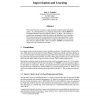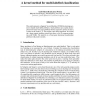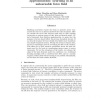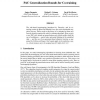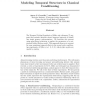101
Voted
NIPS
2001
15 years 2 months ago
2001
In previous work on "transformed mixtures of Gaussians" and "transformed hidden Markov models", we showed how the EM algorithm in a discrete latent variable mo...
94
Voted
NIPS
2001
15 years 2 months ago
2001
This article presents a 2-phase computational learning model and application. As a demonstration, a system has been built, called CHIME for Computer Human Interacting Musical Enti...
89
Voted
NIPS
2001
15 years 2 months ago
2001
In this paper we introduce a new sparseness inducing prior which does not involve any (hyper)parameters that need to be adjusted or estimated. Although other applications are poss...
NIPS
2001
15 years 2 months ago
2001
This article presents a Support Vector Machine (SVM) like learning system to handle multi-label problems. Such problems are usually decomposed into many two-class problems but the...
NIPS
2001
15 years 2 months ago
2001
To find out how the representations of structured visual objects depend on the co-occurrence statistics of their constituents, we exposed subjects to a set of composite images wit...
NIPS
2001
15 years 2 months ago
2001
Reaching movements require the brain to generate motor commands that rely on an internal model of the task's dynamics. Here we consider the errors that subjects make early in...
NIPS
2001
15 years 2 months ago
2001
Acetylcholine (ACh) has been implicated in a wide variety of tasks involving attentional processes and plasticity. Following extensive animal studies, it has previously been sugge...
NIPS
2001
15 years 2 months ago
2001
The rule-based bootstrapping introduced by Yarowsky, and its cotraining variant by Blum and Mitchell, have met with considerable empirical success. Earlier work on the theory of c...
NIPS
2001
15 years 2 months ago
2001
The adaptive TAP Gibbs free energy for a general densely connected probabilistic model with quadratic interactions and arbritary single site constraints is derived. We show how a ...
110
Voted
NIPS
2001
15 years 2 months ago
2001
The Temporal Coding Hypothesis of Miller and colleagues [7] suggests that animals integrate related temporal patterns of stimuli into single memory representations. We formalize t...

